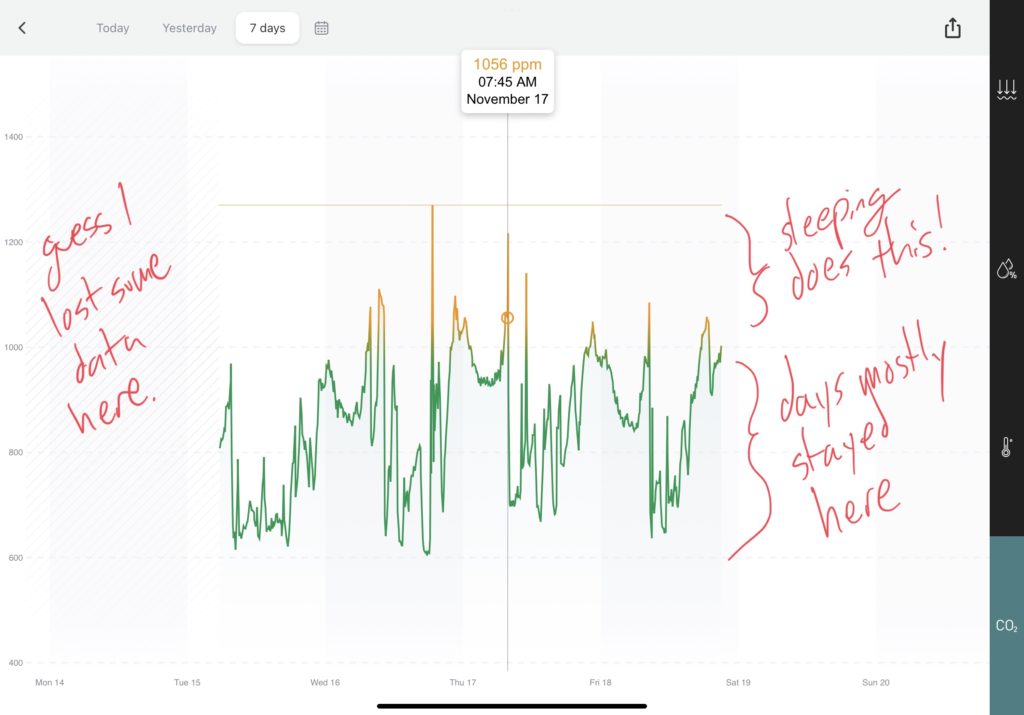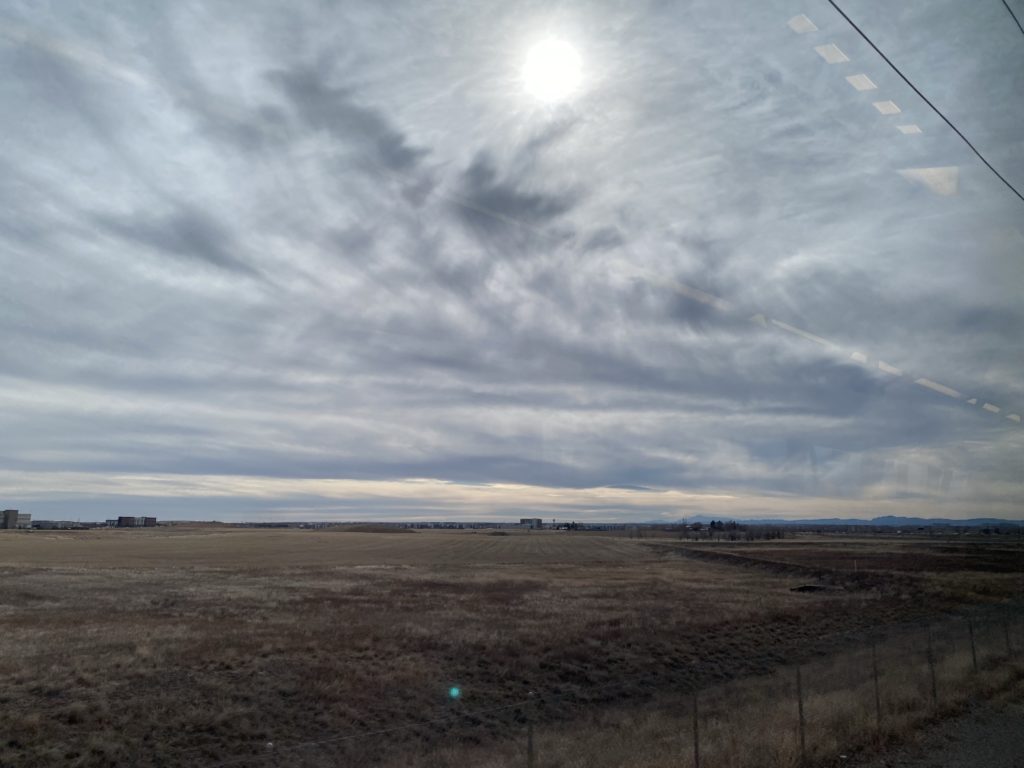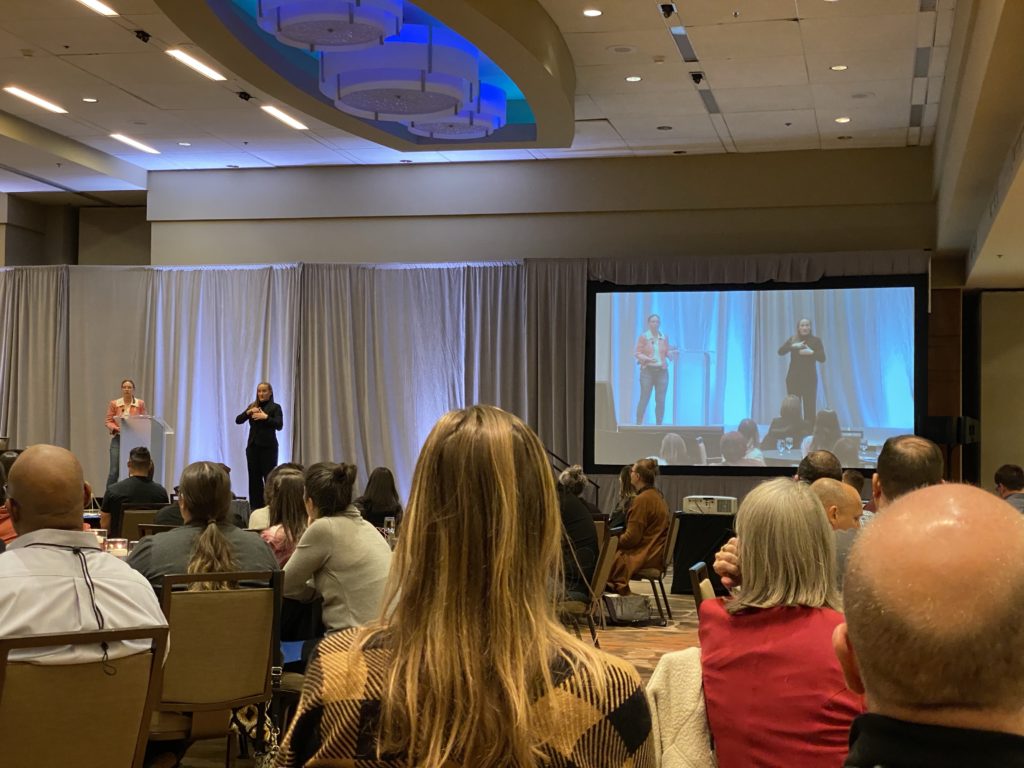On this last day of the 2022 Accessing Higher Ground accessibility in higher education conference, I put together a thread about the week. Originally posted on Mastodon, this is a lightly edited version for this blog. Be warned, this isn’t short. :)

High-level thoughts from a first-time attendee: This is a really good conference. I haven’t seen much in the way of glitches or issues (discounting the occasional technical electronic weirdness that happens anywhere). Panel content has been well selected and planned; I’ve been able to put together a full schedule with few “this or that” conflicts. Some panelists are better than others, as always, but I haven’t seen any trainwrecks or other disasters.
I do wish the conference had more of a social media presence. The @AHGround Twitter account linked from the AHG website hasn’t posted since 2017, and the #ahg22 hashtag I only found on their Facebook page, and it wasn’t mentioned until 10 days before the conference. Unsurprisingly, this means that there was very little hashtag use (at first I seemed to be one of the very few users other than AGH itself using the tag consistently or at all; a few more people started using it as the conference went on).
The hotel is a Hilton. My primary other hotel experience is the DoubleTree by Hilton Seattle Airport (where Norwescon is held), and I was amused that in most respects, I prefer the DoubleTree to the Hilton Denver City Center. The room is a little smaller here, and I was welcomed at check-in with a room temperature bottle of water instead of a fresh-baked chocolate chip cookie. But these are small and kind of picky distinctions; really, it’s exactly what you’d expect from a Hilton.

That said: This particular hotel has excellent ventilation. I’ve been carrying around an Aranet4 air quality monitor, and it has stayed comfortably in the green nearly the entire time; it has only gone into the low end of the yellow during one standing-room-only session in a smaller room. It did get into the yellow as it sat in my room overnight as I slept, but opening the window would bring it back into the green in just a few minutes (though at 20°-40° F outside, I didn’t do this much).

As noted in an earlier Mastodon post, the weirdest thing for me has been part of switching from fan convention to professional conference: the lack of anything after about 5 p.m. I’m used to fan-run SF/F cons like Norwescon, with panels running until 9 p.m. or later, evening concerts or dances, 24-hour game spaces, and a general “we’ll sleep when this is done” schedule. Having nothing left for the day after about 5 p.m. is odd, and it feels weird not to know that I could wander out and find things going on.
For people who come with groups and/or have been doing this for a long time and have a lot of connections, I’m sure it’s easy to find colleagues to have dinner or hang out in bars or restaurants (at or outside the hotel) and chat with. But for a new solo attendee, it meant I spent a lot of evenings watching movies on my iPad in my room. (I did find a small group of other Washington-based attendees to hang with one evening, which was very appreciated.)
Impressions of Denver: Hard to say, really. It’s been pretty cold this week (20s to 30s most days), and since a lot of panels caught my eye, I didn’t take time to go exploring beyond going to the 16th street mall to find food. The little I did see in the immediate area is nice enough; maybe I’ll see more if I get to come back to AHG in the future.

Colorado itself, I have to say, didn’t give me the greatest first impression. The trip from the airport to downtown Denver is a 40-minute light rail ride through flat, brown, high desert with lots of scrub brush, punctuated by aesthetically unpleasing industrial and commercial areas. Maybe it’s nicer in the summer, but in the winter? The SeaTac-to-Seattle light rail ride is much prettier. (My apologies to Coloradans for snarking on their state.)

My least favorite part has been the humidity, or lack thereof. Coming from the Pacific Northwest’s pretty regular 50%+ humidity, having Colorado’s humidity hovering around the 20% level has been horrible on my skin. Even with lotion, I’m itching like crazy, to the point where it’s been difficult to sleep, and my hands are so dry that the skin of my knuckles is cracking and I look like I’ve been punching walls. Whimper, whine, yes, whatever, it’s unpleasant.
But anyway! And now, brief (500-character or fewer) overviews of the sessions I attended while I’ve been here:
InDesign Accessibility (full-day pre-conference session): For a long time, I’ve had a basic impression that PDFs are crap for accessibility. Turns out that PDFs can be made quite accessible, but it takes a bit of work and the right tools, and InDesign is a powerful tool for this sort of thing. While I don’t use InDesign much, I learned a lot about PDF accessibility and how to effectively prepare documents, and many of the concepts will be translatable to other programs. Very useful.
Addendum: I’d also like to take some time to see how many of these techniques and accessibility features are also available in Affinity Publisher, since I’m a fan of Affinity’s alternatives to Adobe’s big three tools (Photoshop, Illustrator, and InDesign). I have no idea how much of a priority Affinity puts on accessibility (either within their tools or the final documents), but it could be an interesting thing to poke around with.
Using NVDA to check PDFs for Accessibility (full-day pre-conference session): Another really useful day. While I’ve known about screen readers as a concept for some time, I’ve just started experimenting with NVDA over the past year, and as a sighted user who doesn’t depend on it, it can be an overwhelming experience. This day gave me a ton of info on tips for using NVDA (including the all-important “shut up for a moment” command), and I’m going to be much more comfortable with it now.
Keynote: Oh, also: The keynote speaker, Elsa Sjunneson, was excellent, speaking about her experiences as a Deafblind person, student, parent, and author. Her statement that “disability is a multiverse” resonated with a lot of people. Plus, it was a treat to see her speak here, as I know of her from her paneling at Norwescon and her Hugo nominations and wins.

Publishing and EPUB 101: An introduction to EPUBs and an overview of some of the better creation tools. I’ve experimented a bit with creating EPUBs here and there in the past, and am familiar enough with the basics that this one was slightly below my knowledge level, but it still gave me some good tips on methods and tools for preparing documents to be output as accessible EPUB files for distribution.
Math and STEM: Since I’m going to be training STEAM faculty on what they need to know to make their courses accessible, which can have some extra considerations to be aware of, this seemed like an obvious choice. It ended up being basically a demonstration of TextHelp’s Equatio equation editing product, which isn’t necessarily a bad thing, as Equatio does do a lot of neat stuff and our campus already has access to it, so I did learn a lot from the session, even with the single-product focus.
Retire the PDF: An intentionally hyperbolic title, this was a call to consider EPUBs as an alternative to PDFs when distributing documents. As long as you’re not absolutely wedded to the visual layout and presentation of a document, EPUBs do have a lot of advantages over PDFs by giving the end user more control over the display (fonts, sizes, reflow to varying screen sizes, etc.) and better screen reader compatibility (especially when compared to poorly constructed PDFs).
Educational Alt Text: A particularly good session on how to think about writing alt text for images, with an emphasis on doing so for an educational context. Thinking about not simply describing the contents of an image, but creating alt text that conveys the meaning and what information the reader needs to get from the image separate from how the image appears, and how to craft effective alt text and (when technologically possible) long descriptions with more information about the image.
Going Further with EPUB: This session got deeper into the innards of EPUBs, looking at how they’re constructed (essentially self-contained XHTML websites), examining a few different tools for creating, editing, checking, and validating EPUBs for full accessibility. Again, much of the basic info I knew, but the collection of tools and verification options will be very handy to have.
Accessible Math Roadmap: Presenting an in-progress reference document on the state of accessible math and the various tools out there for creating and interacting with equations in accessible formats. As noted above, this is an area I’m trying to learn the basics of as quickly as possible, so I’ll be digging into the reference document itself in more detail in the coming days as I continue preparing to help train faculty on how they can do all this for their classes.
Trending Tech Tools: This is apparently the latest in a recurring series of presentations at this conference, going over major developments in accessible technology over the past year, recent updates to a number of widely used tools, and a peek at things coming down the line in the coming months. Particularly for someone new to the field, this was a nice way to get a snapshot of where things stand and what to be aware of.
Advanced VPAT Techniques: Voluntary Product Accessibility Templates (VPATs) are a way for vendors to declare how accessible their products are (or aren’t); this session discussed how best to approach talking with vendors about their VPATs, particular things to look for, and ways to guide discussions with vendors to get more precise information about issues that may be noted when reviewing the VPATs during the pre-selection product investigation and review phase.
Accessible Videos: Covered what needs to be done to make videos accessible, for both the videos themselves (using high-contrast text within the videos, including correct captions, transcripts, and audio description tracks) and the video players themselves, which need to be accessible and allow full access to all features for all users (which most players, including YouTube’s, aren’t very good at doing). Got some good pointers on automated-caption correction workflows and tools as well.
Integrating Tech in Communication: Through no fault of the presenters, this ended up being the least directly useful to me, as while it was about ways to use tech to communicate with students, it was presented by people on a Microsoft-focused campus, and was essentially a rundown of many of the features built into Microsoft’s applications and how they’re using them on their campus. Not bad info at all, just not as useful for me as it obviously was for others in attendance.
So that wraps up my week at Accessing Higher Ground! It was well worth coming, and I’m very glad I was able to come. If I only get to go to one conference next year, it will probably be the big AHEAD conference (along with ATHEN, one of the two parent organizations for AHG), as they’ll be in Portland, but if we have the resources to send me to two conferences, I definitely hope to come back to AHG again. Thanks to the organizers and all the presenters and attendees for such a good conference week!
